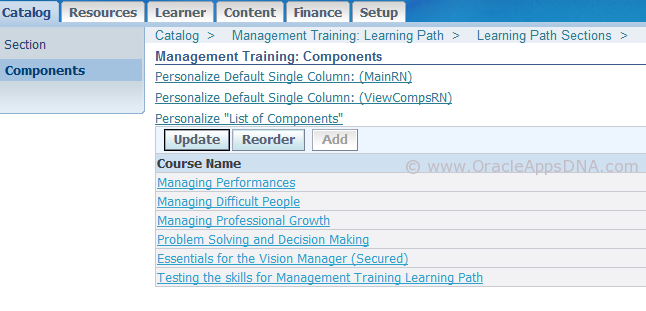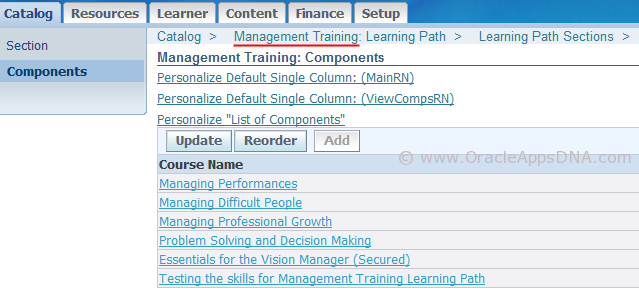Purpose of Learning Path:
A learning path is a catalog object that is used to group sequence of courses together and tracked as a whole. Learning path shows the way to achieve goals of a learner. Eg:- A new employee on board learning where the learner needs to complete a set of courses, by a relative targeted date (for example, 3 months from the date they are subscribed to the path).
Learning path types come from three sources:
- Catalog learning paths, created by a learning administrator, appear in the learner catalog and enable multiple learners to follow a path.
- Manager learning paths enable managers to specify courses of study for their employees, either directly or as a result of another Human Resources activity such as a performance appraisal.
- Learner learning paths, created by learners to set their own goals, define a plan to achieve them, and measure their progress along the way.
The above screenshot shows the member components(courses) of a learning path ‘Management Training’. These components are part of sections in learning path. A section is used to group some set of courses, courses in the section can be mandatory or optional. A learner, to complete the learning path he must complete all mandatory courses.
Features of Learning Path:
- Learners and managers can create individual learning paths within OLM.
- Appraisers and managers can create learning paths from Performance Management.
- Learning path is simply a container for a logical grouping of existing courses, with some added attributes at the learning path level.
- If competencies are set to the learning path, upon its completion a learner will get these competencies in addition to competencies that already exist at the individual course level.
- A learning path can be created with a Target completion Period which is useful to set a deadline for a learner to achieve their goals in terms of their performance reviews and career planning.
Subscriptions and Enrollments of learning path
When learners subscribe to a learning path, the application does not automatically enroll them in any of the component classes. Instead learners should search for offerings and classes for each of the components they wish to take and subscribe to them.
Similarly, when learners unsubscribe from a learning path, the application does not unenroll them from the component classes. Learners should unenroll from individual classes.
Learning paths have no effect on enrollment or learner access. Learners require access to the individual components in order to enroll in a class, whether or not the learners have access to the learning path.

